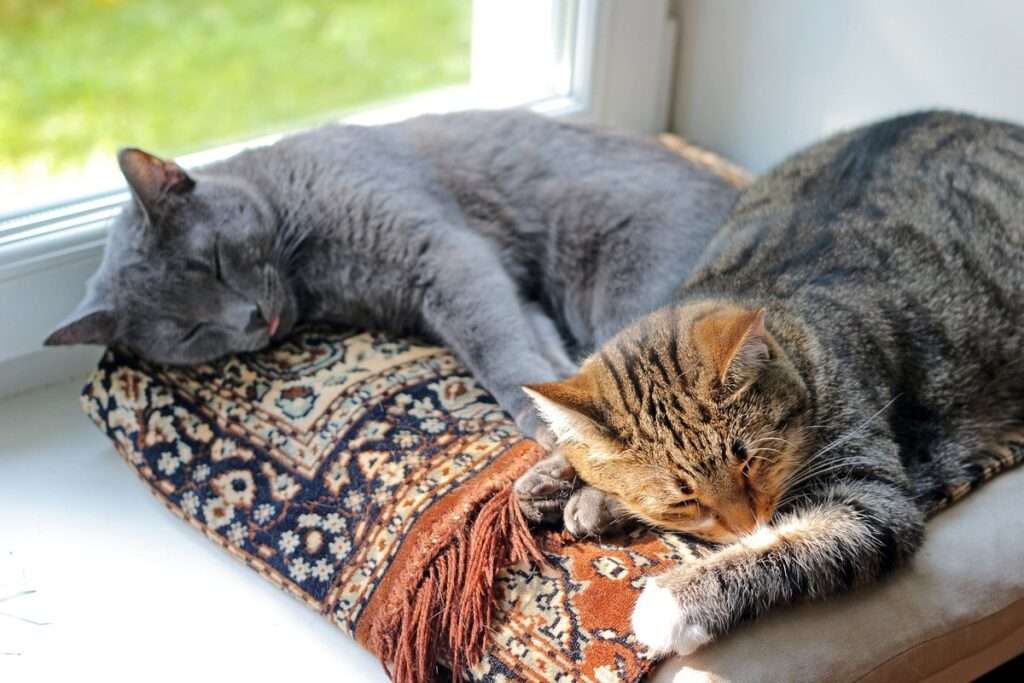Why Is My Russian Blue Cat So Mean? Expert Insights & Solutions
If you’re a proud owner of a Russian Blue cat, you’ve likely experienced the enigmatic charm and allure of this beautiful feline companion. Their shimmering silver-blue coat and striking green eyes make them a unique and sought-after breed. However, some Russian Blue cat owners may find themselves scratching their heads, wondering, “Why is my Russian Blue cat so mean?”
In this insightful article, we’ll embark on a journey to demystify the behavior of Russian Blue cats. By gaining a deeper understanding of your Russian Blue’s personality and behavior, you’ll be better equipped to provide them with the care and love they deserve. So, let’s dive into the world of Russian Blue cats and unravel the secrets behind their sometimes mysterious demeanor.
Meet the Russian Blue: A Glimpse into Their Background
To truly comprehend your Russian Blue cat’s behavior, it’s essential to begin with a glimpse into their unique background. These elegant cats have a rich history that has shaped their distinctive traits and personalities.
The Russian Blue cat, also known as the Archangel Blue or the Archangel Cat, has an origin story as intriguing as their name suggests. These cats can be traced back to the port of Arkhangelsk in Russia, where they were believed to have been companions to European sailors and traders. Over time, these seafaring cats made their way to Europe, where they gained popularity among royalty and the aristocracy.
One of the most recognizable features of the Russian Blue cat is their luxurious coat. Their short, dense, and plush fur is a soft shade of silver-blue, and it’s as velvety to the touch as it is captivating to the eye. This distinctive coat, combined with their bright green eyes, sets them apart from other breeds, making them truly unforgettable.
But what about their personality? Russian Blue cats are often described as having a reserved and shy nature. This can sometimes lead to misconceptions about their behavior. In reality, they possess a unique blend of traits, including intelligence, playfulness, loyalty, and affection, which we will delve into further in the upcoming sections of this article.
Common Behavior Traits of Russian Blue Cats
A journey into the world of Russian Blue cats wouldn’t be complete without an exploration of their common behavior traits. These beautiful felines have a distinctive personality that may sometimes be misunderstood. Let’s uncover the various aspects of their character that make them truly unique.
Russian Blue cats are often characterized by their shyness and reserved nature. They tend to be cautious around strangers and may take some time to warm up to new people or environments. This doesn’t mean they’re “mean”; it’s simply a part of their charming personality.
Intelligence is another key trait of Russian Blue cats. These felines are known for their sharp minds and problem-solving abilities. This intelligence is often coupled with independence, making them self-reliant pets that don’t constantly demand attention.
Despite their initial shyness, Russian Blue cats are playful and agile. They love interactive play and can be quite entertaining with their acrobatic antics. Their agility is a testament to their innate athleticism.
One of the most endearing qualities of Russian Blue cats is their loyalty and affection towards their human companions. Once they form a bond with you, they can be incredibly devoted. Their deep attachment is a reminder of the importance of patience and understanding when building a strong relationship with your Russian Blue.
Recognizing the Factors that Influence Behavior
To truly understand the behavior of your Russian Blue cat, it’s crucial to consider the factors that influence their actions. These felines, like all pets, are shaped by a combination of genetics, early experiences, and their environment. Let’s delve deeper into these influential factors.
- Genetics and Breed-Specific Traits: Russian Blue cats have a genetic predisposition to certain personality traits. As we mentioned earlier, their reserved nature and shyness can be linked to their genetics. However, it’s important to remember that while breed traits provide a general framework, individual variation is common. Not all Russian Blue cats will exhibit the same behavior.
- Early Socialization and its Impact: Early socialization plays a significant role in a cat’s behavior. If a Russian Blue cat is properly socialized during kittenhood, they are more likely to be confident and friendly. However, a lack of socialization or negative experiences during this critical period can lead to shyness or fearfulness. Understanding your cat’s past experiences is crucial to addressing their behavior effectively.
- Environmental Factors: Your cat’s home environment can greatly influence their behavior. A stable, safe, and stimulating environment is essential for Russian Blue cats. Factors such as the presence of other pets, the layout of your home, and the availability of enrichment activities can all impact your cat’s disposition.
- Individual Differences: It’s essential to recognize that every Russian Blue cat is a unique individual. Just like people, they have their own quirks, preferences, and triggers. Some may be more outgoing, while others may be more reserved. Understanding your cat’s individuality is key to forming a strong bond and addressing any behavioral concerns.
Why Is My Russian Blue Cat So Mean?
In this section, we aim to unravel the concept of “mean” behavior in cats, specifically focusing on Russian Blue cats. It’s important to start by defining what “mean” behavior entails and then delving into the possible reasons behind it.
- Defining “Mean” Behavior in Russian Blue Cats: When cat owners describe their Russian Blue cats as “mean,” they often mean behaviors such as hissing, growling, swatting, or even biting. It’s crucial to note that such behaviors usually stem from fear, anxiety, or stress rather than inherent meanness. Your cat may be trying to communicate their discomfort in the only way they know how.
- Common Reasons behind Aggressive or Unfriendly Behavior: Russian Blue cats may exhibit aggressive behavior for various reasons. It could be due to a perceived threat, a response to changes in their environment, or an attempt to establish boundaries. Understanding the root cause of these behaviors is the first step towards addressing them effectively.
- Differentiating Aggression from Other Behavioral Issues: It’s important to differentiate between aggression and other behavioral issues. Aggression is a defensive response to a perceived threat, while other behavioral problems, such as inappropriate urination, may have different underlying causes. By pinpointing the issue, you can tailor your approach to find a solution.
- Importance of Patience and Empathy: When faced with what may seem like “mean” behavior, it’s crucial to respond with patience and empathy. Remember that your Russian Blue cat is not trying to be malicious; they’re expressing their distress in the only way they know how. By approaching the situation with understanding and compassion, you can help your cat feel more secure and ease their discomfort.
The Importance of Socialization and Training
Russian Blue cats, like all feline companions, benefit from proper socialization and training. In this section, we’ll emphasize the role of early socialization in shaping your cat’s behavior and provide practical guidance for creating a harmonious bond.
- The Role of Early Socialization: Early socialization is the cornerstone of a well-adjusted cat. If your Russian Blue was properly socialized during kittenhood, they are more likely to be confident and adaptable. Positive experiences with various people, environments, and other pets can significantly influence their future behavior.
- Tips for Socializing Your Russian Blue Cat: If your cat missed out on early socialization, or if they exhibit shyness, you can still help them become more sociable. Gradual exposure to new experiences, people, and pets can help your Russian Blue gain confidence. Reward-based training and patience are key components of this process.
- Positive Reinforcement Training Techniques: Training your Russian Blue cat using positive reinforcement techniques can help shape their behavior in a desirable way. Rewarding good behavior with treats or praise encourages them to repeat those behaviors, making training a positive experience for both you and your cat.
- Seeking Professional Help If Needed: In some cases, addressing behavioral issues may require the assistance of a professional, such as a feline behaviorist or a veterinarian. These experts can assess your cat’s specific issues and provide tailored solutions, helping you build a more harmonious relationship with your Russian Blue.
Addressing Common Behavioral Issues
In this segment, we’ll explore common behavioral issues that Russian Blue cat owners may encounter. We aim to shed light on these challenges and provide guidance on how to address them effectively.
- Aggression Towards Other Pets: Russian Blue cats, like many felines, can sometimes display aggression towards other pets. This aggression can be triggered by territory disputes, competition for resources, or simply personality clashes. Strategies for introducing pets, providing separate spaces, and gradual exposure can help mitigate this issue.
- Aggression Towards Humans: Aggression towards humans is a concern that can arise in any cat breed, including Russian Blues. Understanding the triggers for aggression, such as fear, pain, or territoriality, is the first step in addressing this behavior. It’s crucial to approach your cat with gentleness and patience and seek professional guidance if necessary.
- Destructive Behavior: Destructive behavior, such as scratching furniture or chewing cords, can be frustrating. Offering appropriate outlets for these behaviors, such as scratching posts and toys, can redirect their energy and protect your home.
- Excessive Vocalization: Excessive vocalization is a common concern among cat owners. Russian Blue cats, although generally quiet, can sometimes meow excessively due to various reasons, including loneliness or boredom. Ensuring their physical and mental needs are met, as well as providing companionship, can help reduce this behavior.
- Litter Box Problems: Litter box problems can be a source of frustration. Russian Blue cats may refuse to use the litter box for reasons like stress or medical issues. It’s important to address these problems promptly, consult with a vet, and provide a clean and accessible litter box.
- Anxiety and Stress-Related Issues: Anxiety and stress can manifest in various ways in cats, including aggression, hiding, or destructive behavior. Creating a calming environment, offering comforting routines, and using techniques like pheromone diffusers can help reduce anxiety and stress in your Russian Blue.
Understanding and addressing these common behavioral issues requires patience, empathy, and a proactive approach. By identifying the root causes and taking the necessary steps, you can help your Russian Blue cat lead a happier and more balanced life.
Creating a Cat-Friendly Environment

To foster a peaceful and harmonious relationship with your Russian Blue cat, it’s essential to provide an environment that caters to their unique needs and instincts. Here are some ways to create a cat-friendly space that enhances your cat’s well-being.
- Designing a Safe and Stimulating Living Space: Ensure your home is a safe and enriching environment for your Russian Blue. Remove hazards such as toxic plants or harmful chemicals, and provide plenty of vertical spaces, hiding spots, and cozy nooks for your cat to explore and relax.
- Providing Mental and Physical Enrichment: Russian Blue cats thrive on both mental and physical stimulation. Offer a variety of toys, puzzle feeders, and interactive playtime to keep their minds engaged and bodies active. This can help prevent boredom and reduce the likelihood of undesirable behaviors.
- Creating a Consistent Routine: Cats, including Russian Blues, thrive on routine. Consistency in feeding, playtime, and sleep schedules can provide a sense of security for your cat, reducing stress and promoting a balanced behavior.
- The Role of Toys, Scratching Posts, and Cat Trees: Invest in a range of cat toys, scratching posts, and cat trees to cater to your Russian Blue’s natural instincts. Providing outlets for scratching and climbing helps satisfy their need for exercise and mental stimulation.
By focusing on creating a cat-friendly environment that addresses their physical, mental, and emotional needs, you can significantly improve your Russian Blue cat’s overall well-being and behavior. A happy and content cat is less likely to exhibit “mean” behavior, and you’ll enjoy a more fulfilling companionship with your feline friend.
Feeding and Health Considerations
The nutritional well-being and overall health of your Russian Blue cat play a crucial role in shaping their behavior. In this section, we’ll delve into the importance of proper feeding and health maintenance.
- The Impact of Diet on Behavior: A well-balanced diet is the foundation of good health and stable behavior in your Russian Blue cat. Ensure that you’re feeding them high-quality cat food that meets their specific dietary needs. Proper nutrition can impact their energy levels, mood, and overall health.
- Regular Vet Check-ups and Preventive Care: Routine veterinary check-ups are vital to monitor your cat’s health and detect any underlying medical issues. Cats are skilled at hiding discomfort, so regular visits can ensure that potential health concerns are addressed promptly. Remember that pain or illness can manifest as behavioral problems.
- Recognizing Signs of Illness or Discomfort: Keep an eye out for subtle signs of illness or discomfort in your Russian Blue. Behavioral changes, such as increased aggression or withdrawal, can be indicative of an underlying health issue. If you notice unusual behavior, consult with your veterinarian to rule out any medical concerns.
- The Role of Proper Nutrition in Reducing Aggression: Nutrition can impact behavior, and it’s particularly important in addressing aggression. Some nutrients, like essential fatty acids, can help reduce aggressive tendencies. Consult with your vet to ensure your cat’s diet supports their emotional well-being.
By focusing on the health and dietary needs of your Russian Blue cat, you can make a positive impact on their behavior and overall happiness. A healthy cat is more likely to exhibit balanced behavior, making your companionship even more enjoyable.
Seeking Professional Help
While many behavioral challenges with Russian Blue cats can be addressed with patience and dedication, there are situations where professional guidance becomes essential. Learn when it’s appropriate to seek help from experts in feline behavior and how they can assist you.
- When to Consult a Veterinarian or Feline Behaviorist: If you find that your Russian Blue cat’s behavior issues persist despite your efforts, or if the issues are severe and affecting their quality of life, it’s time to consult a veterinarian or a feline behaviorist. These professionals have the expertise to diagnose underlying medical conditions and provide tailored solutions for behavior problems.
- What to Expect During a Behavior Assessment: A behavior assessment typically involves a thorough evaluation of your cat’s history, behavior, and living environment. It may also include observations of your cat’s reactions to various stimuli. This assessment helps the expert understand the root causes of the behavioral issues and develop a targeted plan for improvement.
- Treatment Options, Including Medications: Depending on the assessment, treatment options may include behavior modification techniques, training, and environmental adjustments. In some cases, medication may be prescribed to manage anxiety or aggression. These treatments are designed to create a happier, more balanced life for your Russian Blue cat.
- Success Stories of Cats Who Benefited from Professional Guidance: We’ve seen many Russian Blue cats go through remarkable transformations with the help of professionals. These success stories often involve a combination of behavior modification, proper training, and sometimes medication. The commitment of the owners, alongside expert guidance, has led to happier and more peaceful relationships.
In cases where behavioral issues are complex or deeply rooted, seeking professional help can be a crucial step towards improving your cat’s behavior and enhancing your relationship. Remember that you’re not alone, and there are experts available to support you on this journey.
Conclusion
In the world of Russian Blue cats, understanding and addressing behavioral challenges is a rewarding journey that ultimately leads to a stronger bond between you and your feline companion. As we conclude this comprehensive guide, let’s recap the essential takeaways and offer some final words of encouragement.
Your Russian Blue cat’s behavior, often perceived as “mean,” is a product of various factors, including genetics, early experiences, and their living environment. It’s important to remember that these behaviors are not indicative of inherent meanness but are their way of communicating their needs, fears, or discomfort.
Even though challenging, your Russian Blue cat’s behavior can be understood and improved with the right knowledge and approach. By embracing the unique traits of this magnificent breed and providing the care they deserve, you can enjoy a loving and lasting connection with your Russian Blue companion. Remember, patience, empathy, and professional guidance are your allies on this journey towards a happier and more fulfilling relationship with your feline friend.
Frequently Asked Questions
Why is my Russian Blue cat so shy and reserved?
Russian Blue cats are known for their reserved nature, which is often a result of their breed’s characteristics. They may be cautious around strangers and take time to warm up to new people or environments. This shyness is not an indicator of meanness; it’s a part of their unique personality.
How can I socialize my Russian Blue cat if they are shy?
Socializing a shy Russian Blue cat can be achieved through patience and gradual exposure. Start by introducing them to new experiences and people in a controlled and positive way. Reward them with treats and affection when they display confidence or calm behavior.
My Russian Blue cat hisses and swats at me. Is this normal?
While hissing and swatting can be unsettling, they are typically defensive responses to feeling threatened or anxious. It’s not indicative of meanness. Your cat might be trying to communicate their discomfort. Provide a safe and comforting environment and avoid triggering situations.
What is the role of diet in reducing aggression in Russian Blue cats?
Diet can influence a cat’s behavior. Essential nutrients and fatty acids in their diet can help reduce aggressive tendencies. Consult with your veterinarian to ensure that your cat’s food supports their emotional well-being.
Should I consider getting another pet to keep my Russian Blue cat company?
Introducing another pet can be a great way to provide companionship for your Russian Blue cat. However, careful introductions and consideration of your cat’s personality and preferences are essential. Some Russian Blues thrive with feline or even canine companions, while others may prefer to be the sole pet.
How can I stop my Russian Blue cat from scratching my furniture?
Providing your Russian Blue with appropriate outlets for scratching is crucial. Invest in scratching posts and pads and encourage them to use these designated areas by rewarding good behavior. Avoid punitive methods, as they can lead to stress and more destructive behavior.
What should I do if my Russian Blue cat exhibits excessive vocalization?
Excessive vocalization can be a sign of loneliness, boredom, or stress. Ensure your cat’s mental and physical needs are met, offer companionship, and engage in interactive play. If the issue persists, consult with a veterinarian to rule out underlying medical concerns.
How can I know if my Russian Blue cat needs professional help for their behavior?
If you’ve tried various strategies and your cat’s behavior issues persist, or if the issues are severe and affecting their quality of life, it’s time to seek professional help. Consulting a veterinarian or a feline behaviorist can help you identify the root causes and develop a targeted plan for improvement.
Can I train my Russian Blue cat to be less shy and more sociable?
While you can encourage socialization in your Russian Blue, it’s important to respect their individual temperament. Some shyness is typical for the breed. Gradual exposure to new experiences and positive reinforcement can help, but it’s essential to accept and love your cat for who they are.
Are Russian Blue cats good with children and other pets?
Russian Blue cats can get along well with children and other pets, but introductions and socialization are key. Their reserved nature means they may take time to adjust, so gradual introductions and a controlled environment are crucial to ensure positive interactions.





